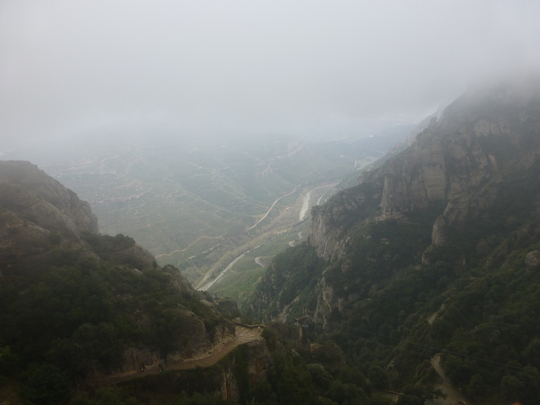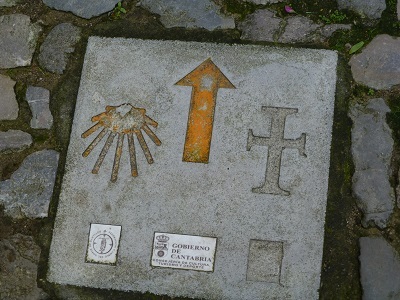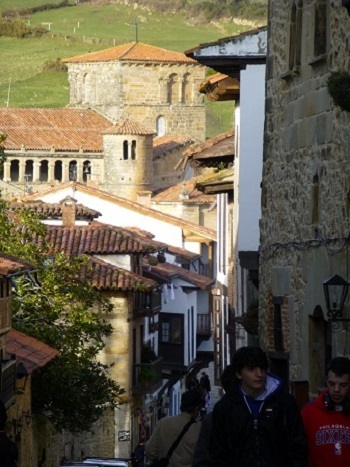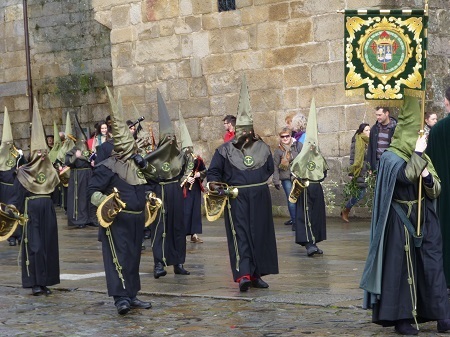From a monastery roof in Montserrat, forty-one miles northwest of Barcelona, I angled my camera to get a shot of the wide clay path that led to a ravine between two mountains and disappeared to the west in the direction of Santiago de Compostela. It was the Northern Way, also known as the Camino del Norte and the Way of St. James.
Looking Down at the Northern Way, One of the Many Routes to Santiago de Compostela
For a moment I longed to be on that trail. Then I thought no. It was March and the weather was too cold and rainy. I'd heard the best time for the journey is later in the spring or early in the fall. My husband Rob and I were following the above route by bus rather than foot Go Ahead's "Barcelona and Northern Spain" trip. No worries about following signs in the woods, blisters, backaches from carrying heavy packs, not to mention bedbugs at way stations where we would have spread out our sleeping bags for the night. Though we often rent a car on European trips, it was freeing not to worry about finding the correct parking places in cities, paying high insurance rates, or navigating hairpin turns in blinding rainstorms.
Traveling across northern coast from Barcelona, on the border of France, to Santiago de Compostela had been on our wish list for a long time, and seemed the perfect replacement for a cancelled trip to Egypt. After narrowing down the choice to two tour companies offering similar routes, we found that GoAhead had the advantage of actually visiting the inside of the Guggenheim Bilbao Museum rather than just passing by and seeing the outside, plus flying to Madrid instead of taking the seven hour bus from Santiago de Compostela to Madrid at the end.
Directional Sign Imbedded on a Sidewalk Point out the Way to Sanitago de Compostela. Lines on the Scallop Symbolize the Many Routes Pilgrims Have Followed for the Past 1200 Years.
In twelve actual traveling days, we touched the glass ball that covers the much worn fingers of the Black Virgin of Montserrat, strolled down the winding streets of Pamplona that have been used by pilgrims for centuries, and are also the route of the annual Running of the Bulls Festival each July, and hiked up and down the cobblestone streets in the Renaissance town of Santillana del Mar, surrounded by horse farms and mountains.
The Main Street of Santillana del Mar Leads Downhill to One of the Oldest Pilgrimage Churches in Europe. Mountains are a backdrop.
Colegiata de Santa Juliana, the 11th century pilgrimage church in Santillana del Mar, actually dates back to 870 A.D., when monks created a hermitage for their village's patron Saint Juliana. Simply decorated, it had not been rebuilt as a Gothic cathedral or embellished with bright gold baroque in the 17th and 18th centuries.
In small cities such as Oviedo and Lugo, with its intact Roman walls, we went through cathedrals with the traditional pilgrimage architecture, built so that a that visitor would come in on one side, walk down behind the altar to pay respects to the relics, and then walk out the other side. During the Middle Ages, travelers who'd come a long way would sometimes sleep in the clerestory, or clear story, a level high up and surrounded by windows that would let in light.
Over the centuries towns in Italy, France and Spain expanded when their church was a stop for religious travelers. Santiago de Compostela, the destination at the end of many European pilgrim routes, was a prime example. Legend has it that the relics of St James were carried here from Jerusalem in the first century.
Members of the Order of St. James, One Part of the Elaborate Good Friday Procession.
Once we reached the main square of Santiago de Compostela, we found ourselves in the midst of a diverse crowd of modern day pilgrims ranging from teens to seventy and eighty year olds who had come to the end of their journey. They'd done the trail for various reasons -- spiritual, cultural, or for sport, and were ready to have their compostelas, or certificates, stamped. Travelers from Italy, France, and other locations stood chatting with gear on their backs, some in the latest style athletic clothing, others in simpler black garb, some in a single color identifying them as part of a group. They looked both relieved and excited.
Fortuitously, we arrived in Santiago just as the Good Friday procession was beginning. Locals were buying palm leaves and olive branches from purveyors on the streets that led to the cathedral square. Shortly before noon, priests in white and priests in black carried high gold crosses. Men from the Order of St. James, covered from head to toe in olive green garb, their peaked hats with eye slits, went before a carriage carrying a large red box, followed by locals, old and young, with olive and palm branches in their hands.
When we arrived home we watched the film The Way, which illustrates the challenges Martin Sheen encountered when he did our route by foot. Yes, we had it much easier, and we probably saw more of pilgrimage sites and the cultural highlights of northern Spain by taking the bus.



